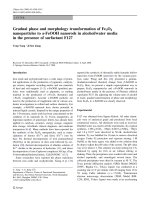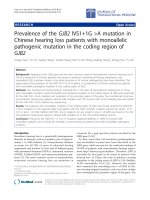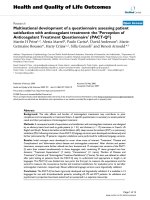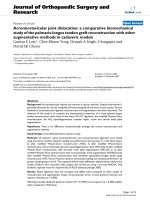- Trang chủ >>
- Khoa Học Tự Nhiên >>
- Vật lý
THE ACOUSTOMAGNETOELECTRIC CURRENT OF a RECT ANGULAR QUANTUM WIRE WITH AN INFINITE POTENTIAL IN THE PRESENCE OF AN EXTERNAL MAGNETIC FIELD
Bạn đang xem bản rút gọn của tài liệu. Xem và tải ngay bản đầy đủ của tài liệu tại đây (162.12 KB, 7 trang )
Proc. Natl. Conf. Theor. Phys. 36 (2011), pp. 114-120
THE ACOUSTOMAGNETOELECTRIC CURRENT
OF A RECTANGULAR QUANTUM WIRE
WITH AN INFINITE POTENTIAL IN THE PRESENCE
OF AN EXTERNAL MAGNETIC FIELD
NGUYEN VAN NGHIA
Department of Physics, Water Resources University
DINH QUOC VUONG
Quangninh Department of Education and Training
NGUYEN QUANG BAU
Department of Physics, College of Natural Sciences, Hanoi National University
Abstract. The acoustomagnetoelectric effect in a rectangular quantum wire with an infinite potential in the presence of an external magnetic field is investigated by using Boltzmann kinetic
equation for an acoustic wave whose wavelength λ = 2π/qz is smaller than the mean free path l of
the electrons and hypersound in the region qz l
1, (where qz is the acoustic wave number). The
analytic expression for the acoustomagnetoelectric current I is calculated in the case: relaxation
time of momentum τ is constant approximation and non-degenerate electron gas. The dependence
of the expression for the acoustomagnetoelectric current I on the acoustic wave numbers q z and
on the parameters of the rectangular quantum wires is obtained. Numerical calculations have been
done and result is analysed for GaAs rectangular quantum wire with an infinite potential. This
result is also compared with the result of the experiment in the normal bulk semiconductors, the
superlattices and the cylindrical quantum wire to show the different.
I. INTRODUCTION
In recent times, there has been more and more interests in studying and discovering
the behavior of low-dimensional system, in particular, one-dimensional systems, such as
quantum wire. In quantum wires, the motion of electrons is restricted in two dimensions,
so that can flow freely in one dimension. The confinement of electron in these systems
has changed the electron mobility remarkably. This has resulted in a number of new
phenomena, which concern a reduction of sample dimensions. These effects differ from
those in bulk semiconductors, for example, electron-phonon interaction and scattering
rates [1, 2] and acoustic-electromagnetic wave interaction [3].
It is well known that, when an acoustic wave propagates through a conductor, it
is accompanied by a transfer of energy and momentum to the conducting electrons. This
gives rise to what is called the acoustoelectric effect [4 - 6]. Recently, the acoustoelectric
effect have investigated this effect in superlattices [7 - 9]. However, in the presence of
a magnetic field the acoustic wave is propagated in the conductor can produce another
effect called the acoustomagnetoelectric (AME) effect. The AME effect is creating an
AME current (if the sample is short circuited in the Hall direction), or an AME field (if
the sample is open) when a sample placed in a magnetic field H carried an acoustic wave
THE ACOUSTOMAGNETOELECTRIC CURRENT OF A RECTANGULAR QUANTUM WIRE...
115
propagating in a direction perpendicular to the magnetic field H. The AME effect was
studied first for bipolar semiconductors [10] and was observed experimentally in bismuth
[11]. In past times, there are more and more interests in studying and discovering this
effect in a bulk monopolar semiconductor [12], in a bulk semiconductor n-InSb [13]. In
this specimen they observed that the AME effect occurs mainly because of the dependence
of the electron relaxation time on the energy and when τ = constant the effect vanishes.
Like the classical magnetic field, the effect also exists in the case of a quantized magnetic
field, and the quantum acoustomagnetoelectric effects due to Rayleigh sound waves have
investigated [14]. The AME effect problems in the bulk semiconductors [12, 13]; in superlattices [15] in the case non-degenerate electron gas and in superlattices [16] in the case
degenerate electron gas have been investigated. However, the AME effect in the quantum
wires has not been studied yet. Therefore, the purpose of this work is to examine this effect
in the rectangular quantum wire (RQW) with an infinite potential for the case electron
relaxation time which is not dependent on the energy and non-degenerate electron gas.
Furthermore, we think the research of this effect may help us to understand the properties
of quantum wire material. We have obtained the AME current I in the RQW with an
infinite potential in the presence of an external magnetic field. The dependence of the
expression for the AME current I on acoustic wave numbers qz and on the parameters of
the RQW with an infinite potential has been shown. Numerical calculations are carried
out with a specific GaAs rectangular quantum wire to clarify our results.
II. ANALYTIC EXPRESSION FOR THE
ACOUSTOMAGNETOELECTRIC CURRENT
It is well known that, when the wavelength λ = 2π
qz of the acoustic wave will be
considered shorter than the electron mean free path l (where qz l >> 1), the sound wave
can be treated as a packet of coherent phonons (monochromatic phonon) having a function
3
= 1, k is the current phonon wave vector,
distribution N (k) = (2π)
ωqz vs φδ(k − qz ). Where
φ is the sound flux density, ωqz and vs are the frequency and the group velocity of sound
wave with the wave vector qz , respectively. The problem will be solved in the quasiclassical case. The magnetic field will also be considered classically, and weak thus limiting
ourselves to the linear approximation of magnetic field H.
We shall consider a situation whereby the sound is propagating along the quantum
wire axis (Oz), the magnetic field H is parallel to the (Ox) axis and the AME current
appears parallel to the (Oy) axis. The electron energy spectrum εn,l,pz of the RQW with
an infinite potential is given by [17]
εn,l,pz =
p2z
π2 2
+
2m
2m
n2
l2
+
a2
b2
.
(1)
Here a and b are, respectively, the cross-sectional dimensional along x- and y-directions,
n, l are the subband indexes, m is the electron effective mass, and pz is the longitudinal
(relative to the quantum wire axis) component of the quasi-momentum.
The density of the acoustoelectric current in the presence of magnetic field can be
written in the form [15]
116
NGUYEN VAN NGHIA, DINH QUOC VUONG, NGUYEN QUANG BAU
j AE =
2e
(2π)3
U AE ψi d3 p,
(2)
with
U AE =
2πφ
{|Gpz −qz ,pz |2 [fα (pz − qz ) − fα (pz )]δ(εn,l,pz −qz − εn,l,pz + ωqz )
ωqz vs
+ |Gpz +qz ,pz |2 [fα (pz + qz ) − fα (pz )]δ(εn,l,pz +qz − εn,l,pz − ωqz )}.
(3)
Here fα (pz ) is the distribution function, α (α ) characterizing the states of electron in the
quantum wire before (after) scattering with phonon, Gpz −qz ,pz is the matrix element of the
electron-phonon interaction and ψi (i = x, y, z) is the root of the kinetic equation given
by [15]
e
∂ψi
(V × H)
+ Wp {ψi } = Vi ,
(4)
c
∂p
here Vi is the electron velocity, V is the average drift velocity of the moving charges and
Wp {...} = (∂f /∂ε)−1 W {(∂f /∂ε)...}. The operator W is assumed to be Hermitian [18].
In the case of the relaxation time of momentum τ is approximately constant, the collision
operator has form Wp = 1/τ . Solving Eq.(4) by the method of iteration, we get for the
(1)
(0)
zero and the first approximation with ψi = ψi + ψi + .... Inserting into Eq.(2) and
taking into account the fact that |Gpz ,p |2 = |Gp ,pz |2 , we obtain for the density of the
z
z
acoustoelectric current the expression
jiAE = −
eφ
s ωqz
2π 2 v
|Gpz +qz ,pz |2 [fα (pz + qz ) − fα (pz )]×
× [Vi (pz + qz )τ − Vi (pz )τ ]δ(εn,l,pz +qz − εn,l,pz − ωqz )d3 p−
−
e2 φτ 2
2π 2 mcvs ωqz
|Gpz +qz ,pz |2 [fα (pz + qz ) − fα (pz )]×
× [(V (pz + qz ) × H)i − (V (pz ) × H)i ]δ(εn,l,pz +qz − εn,l,pz − ωqz )d3 p.
(5)
2
2
|qz |
The matrix element of the electron-phonon interaction [7, 15] is given |Gpz ,qz |2 = |Λ|
2ρωqz .
Where Λ is the deformation potential constant and ρ is the crystal density of the RQW.
In Eq.(5), the first term is the expression of the density of the acoustoelectric current
and the second term is the expression of the density of the AME current. If the external
magnetic field does not exist, then the second term will not exist. Thus, the density of
the AME current is expressed as
jyAM E = −
eφqz2 τ 2 |Λ|2 Ω
4πvs ωq2z ρ
[fα (pz + qz ) − fα (pz )][Vz (pz + qz ) − Vz (pz )]×
× δ(εn,l,pz +qz − εn,l,pz − ωqz )d3 p,
(6)
where Ω = eH
mc is the cyclotron frequency and the Fermi-Dirac distribution function f α (pz )
in the usual form is given by
THE ACOUSTOMAGNETOELECTRIC CURRENT OF A RECTANGULAR QUANTUM WIRE...
fα (pz ) =
1
exp(β(εn,l,pz − µ)) + 1
,
117
(7)
with β = 1/kb T , kb is the Boltzmann constant, T is the temperature of the RQW and µ
is the chemical potential.
In the case a one-dimensional wire, for a non-degenerate electrons gas, the equilibrium electron distribution is described by the one-dimensional Maxwellian function and it
is given by [17]
fα (pz ) = nL
π 2
2mkb T
1/2
exp −
p2z
2mkb T
.
(8)
Substituting Eqs.(1) and (8) into Eq.(6) and taking into account the fact that
∂εn,l,pz
Vz (pz ) = ∂p
, we obtain for the AME current with the condition is satisfied then:
z
εF >
π2 2
p2z
+
2m
2m
n2
l2
+
a2
b2
+ ωqz .
(9)
Where εF is the Fermi energy and the inequalities in Eq.(9) is condition acoustic wave
vector qz to the AME effect exists. Therefor, we have obtained the expression AME
current
I=
eφ|Λ|2 qz3 τ 2 ΩabnL
4vs ωq2z ρ 2 m
1 − exp
n,n ,l,l
π2 2
2mkb T
n 2 − n2
a
+
l 2 − l2
b
+
ωqz
kb T
.
(10)
Eq.(10) is the AME current in the RQW with an infinite potential in the case nondegenerate electron gas, the expression only obtained if the condition in Eq.(9) is satisfied.
III. NUMERICAL RESULTS AND DISCUSSION
In the paper, we consider a GaAs quantum wire. The parameters used in the
calculations are as follows [14, 16, 17]: τ = 10−12 s; Λ = 8eV ; a = b = 100˚
A; nL = 1.0 ×
106 m−1 ; φ = 1014 W m−2 ; H = 2 × 103 Am−1 ; ρ = 2 × 1013 kgm−3 ; vs = 5370ms−1 ; ωqz =
1010 s−1 ; m = 0.067me , me being the mass of free electron.
In the figure 1, we show the dependence of the AME current on the acoustic wave
number qz with the area of cross-sectional a = b = 100˚
A, the intensity of the magnetic
field H = 2 × 103 Am−1 and the temperature T = 77K, T = 100K and T = 300K. The
curve of the AME current I strongly increases when the large value range of the acoustic
wave number qz and this value decreases when the temperature increases. Unlike the
normal bulk semiconductors [12, 13], in the quantum wire the AME current is non-linear
with the acoustic wave number qz . These results are compared with those obtained in the
superlattices [15, 16], the AME current have a non-linear with the acoustic wave number
qz . It is very different between the superlattices and the RQW with an infinite potential.
In the figure 2, we show the dependence of the AME current on the temperature T
of the RQW with the acoustic wave number qz = 1.00 × 106 cm−1 , qz = 1.68 × 106 cm−1
and qz = 1.80 × 106 cm−1 . The value of the AME current strongly decreases with the
118
NGUYEN VAN NGHIA, DINH QUOC VUONG, NGUYEN QUANG BAU
Acoustomagnetoelectric current I (mA)
0.35
0.3
T = 77 K
T = 100 K
T = 300 K
0.25
0.2
0.15
0.1
0.05
0
0
2
4
6
q (cm−1)
8
10
12
6
x 10
Fig. 1. The dependence of the AME current on the acoustic wave number q z .
The density of the AME current jame (mA/cm2)
4.5
q = 1.00x106 cm−1
q = 1.68x106 cm−1
6
−1
q = 1.80x10 cm
4
3.5
3
2.5
2
1.5
1
0.5
0
0
50
100
150
T (K)
200
250
300
350
Fig. 2. The dependence of the AME current on the temperature T .
temperature when the temperature increases in the small value range the low temperature.
This value is approximation constant in the high temperatures T .
In the figure 3, we show the dependence of the AME current on the cyclotron
frequency Ω with the area of cross-sectional a = b = 100˚
A, the acoustic wave number
qz = 1.68 × 106 cm−1 and the temperature T = 77K, T = 100K and T = 300K. When
the intensity of the magnetic field rises up, the AME current I increases linearly with the
THE ACOUSTOMAGNETOELECTRIC CURRENT OF A RECTANGULAR QUANTUM WIRE...
50
Acoustomagnetoelectric current I (mA)
45
119
T = 77 K
T = 100 K
T = 300 K
40
35
30
25
20
15
10
5
0
0
2
4
Omega (Hz)
6
8
10
8
x 10
Fig. 3. The dependence of the AME current on the cyclotron frequency Ω.
cyclotron frequency Ω. This value also decreases when the temperature T of the RQW
increases.
IV. CONCLUSION
In this paper, we have analytically investigated the possibility of the AME effect
in the RQW with an infinite potential. We have obtained analytically expressions for the
AME effect in the RQW with an infinite potential for the case non-degenerate electron gas.
The dependences of the expression for the AME current I on the cyclotron frequency Ω,
the frequency ωqz of the acoustic wave, the temperature T and the cross-sectional area of
the RQW are obtained. The result is different compared to those obtained in the normal
bulk semiconductors [12, 13] and the superlattices [15, 16].
The numerical results have expressed the dependence of the AME current I on
the acoustic wave number q, the cross-sectional area and the temperature of the RQW
are performed for GaAs rectangular quantum wire with an infinite potential. The result
shows that, the AME effect exists when the acoustic wave vector qz complies with specific
conditions in Eq.(9) which condition dependences on the frequency ωqz of the acoustic
wave, the mass of electrons, the temperature and the cross-sectional area of the RQW.
The curve of the AME current I strongly increases when the low temperature and the
large value range of the acoustic wave number qz . The value of the AME current I is
zero (the effect is not appear) when the small value range of the acoustic wave number
qz and the cross-sectional area of the RQW. That is mean to have AME current I, the
acoustic phonons energy is high enough and satisfied in the some interval to impact much
momentum to the conduction electrons.
120
NGUYEN VAN NGHIA, DINH QUOC VUONG, NGUYEN QUANG BAU
ACKNOWLEDGMENT
This research is completed with financial support from the Program of Basic Research in Natural Science − Vietnam NAFOSTED.
REFERENCES
[1]
[2]
[3]
[4]
[5]
[6]
[7]
[8]
[9]
[10]
[11]
[12]
[13]
[14]
[15]
[16]
[17]
[18]
N. Mori, T. Ando, Phys. Rev. B 40 (1989) 6175.
J. Pozela, V. Juciene, Sov. Phys. Tech. Semicond. 29 (1995) 459.
D. E. Lawrence, K. Sarabandi, IEEE Trans. Antennas Propagation 45 (N.10) (2001) 1382.
R. H. Parmenter, Phys. Rev. 89 (1953) 990.
V. L. Gurevich, Phys. Rev. 2 (1968) 1557.
M. Rotter, A. V. Kalameitsev, A. O. Grovorov, W. Ruile, A. Wixforth, Phys. Rev. Lett. 82 (1999)
2171.
S. Y. Mensah, F. K. A. Allotey, S. K. Adjepong, J. Phys. 6 (1994) 6783.
S. Y. Mensah, F. K. A. Allotey, N. G. Mensah, J. Phys. 12 (2000) 5225.
S. Y. Mensah, F. K. A. Allotey, N. G. Mensah, J. Phys. 37 (2005) 87.
A. A. Grinberg, N. I. Kramer, Sov. Phys-Dokl. 9 (N.7) (1965) 552.
T. Yamada, J. Phys. Soc. Japan 20 (1965) 1424.
E. M. Epshtein, Yu. V. Gulyaev, Sov. Phys-Solids State 9 (N.2) (1967) 288.
M. Kogami, S. Tanaka, J. Phys. Soc. Japan 30 (1970) 775.
A. D. Margulis, V. I. A. Margulis, J. Phys. 6 (1994) 6139.
S. Y. Mensah, F. K. A. Allotey, S. K. Adjepong, J. Phys. 8 (1996) 1235.
N. Q. Bau, N. V. Hieu, PIERS Proceeding, March 2010, Xian, China, p. 342.
K. Suresha, S. S. Kubakaddi, B. G. Mulimani, S. L. Lee, J. Phys. E 33 (2006) 50.
M. I. Kaganov, Sh. T. Mevlyut, I. M. Suslov, Sov. JETP 51 (N.1) (1980) 189.
Received 30-09-2011.









